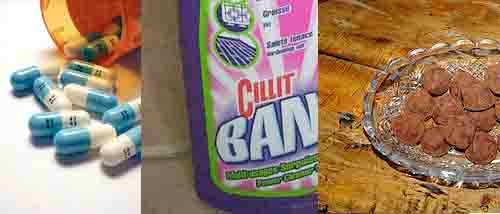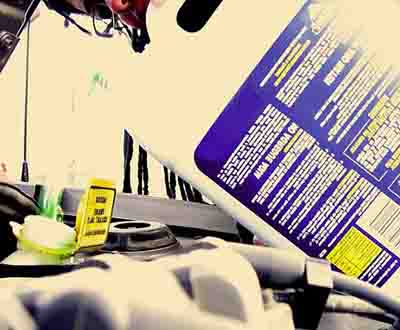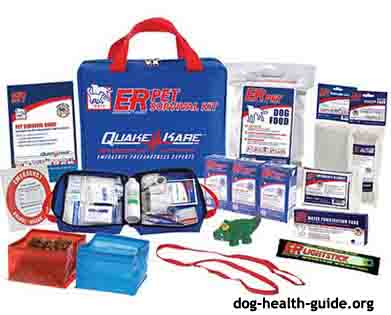Table of Contents
Causes | Chemicals | Foods | Medications | Plants | Hotline | Q&A
Summary:
"There are a number of everyday substances that can lead to dog poisoning. This includes plants, chocolate, grapes, insecticides, artificial sweeteners (xylitol) and even common human medications.
Signs of poisoning in dogs vary based on the toxin. Look for the classic signs of poisoning in dogs including gastrointestinal distress (diarrhea and vomiting), mouth sores and irritation, weakness, appetite loss, a lack of coordination, seizures and collapse.
Common signs include but are not limited to:
- diarrhea
- vomiting
- weakness
- changes in heart rate
- abdominal pain
- difficulty walking
- seizures
- appetite loss
Seek immediate emergency veterinary
attention if you
believe that your dog has been
poisoned. Do not induce vomiting unless instructed by a poison hot-line
(see below) or veterinarian. Inducing vomiting when a caustic substance such as a household cleaner has been swallowed can harm the dog. Be sure to tell the vet the amount
swallowed, the time or how long ago it was swallowed, the weight
of your dog and any
symptoms. Treatment includes washing any skin surfaces exposed to the toxin, stabilizing the patient such as breathing and circulatory status, decontamination of the body through vomiting or charcoal, and supportive care.
The phone number for the ASPC Animal Poison Control Center is (888) 426-4435."

Overview: Causes
Veterinarians will want to know the cause of any poisoning in order to decontaminate and detoxify the patient. The first priority is to stop any toxic substance from being further absorbed into the body. Depending on the cause, a veterinarian could recommend vomiting, cleaning the skin or flushing the eyes. Many of the causes and solutions are described below in the quick reference table and by following the links below:
Top Causes of Dog Poisoning Symptoms and Treatment |
||
|---|---|---|
|
Poison |
Symptoms |
Remedy |
| Chocolate |
Depends on the type, but usually
includes vomiting, diarrhea, hyperactivity, increase urination,
hyperthermia. In chronic cases there can be heart problems, tremors and
seizures. Symptoms are seen when a dog ingests more than 20mg of the
chemical theobrromine. |
Induce vomiting if within 4 to 6
hours of chocolate being ingested if there are no symptoms (chocolate
will stay in the digestive tract for this period of time after
ingestion)Treatment includes several doses of activated charcoal.
Depending on the severity of the problem, treatment can include fluid
therapy in a veterinarians office, something to stop the vomiting,
sedation and heart monitoring. Frequent walks to encourage urination
are used to help clear the body. Chocolate can take 17 hours to move
through the body, with symptoms starting to appear up to 72 hours after
it is eaten. A minority of dogs will develop pancreatitis from eating
chocolate, particularly if the chocolate contains nuts such as
macadamia nuts. |
| Currants,
Raisins, Grapes (all types of grapes) |
Can lead to renal failure since
it believed that dogs cannot metabolize part of the fruit. Since fruits
cannot be broken down, they stay in the gastrointestinal system for a
long time. Can result in vomiting hours after being eaten. After 12 to 24 hours symptoms of grape or raisin poisoning can include vomiting, diarrhea, anorexia (appetite loss0, abdominal pain, bad breath, diarrhea. There is no medically determined minimum number of grapes needed to result in toxicity and symptoms. Because of this, all cases should be treated. 50% of dogs that ingest grapes or raisins develop no clinical symptoms. |
One dose of activated charcoal
can help to prevent absorption. Kidney failure can start after 24 hours
along with hypercalcemia (too much calcium in the blood) and phosphates
in the blood. Kidney failure results in the body not being able to
remove waste products. This can result in large urine output over which
the dog has no control, which in turn causes dehydration and the dog to
be more thirsty. As the kidney failure progresses it can lead to a
diminished capacity to urinate. |
| NSAIDS
(Anti-inflammatory medications, such as ibuprofen and naproxen). Can
also be caused by veterinary medications such as Carprofen and
Deracoxib, Etogesic and Previcoxib. |
Some breeds are more sensitive
than others such as German Shepherds. Each medication causes toxicity at different levels. Signs of NSAID dog poisoning include vomiting with blood, diarrhea, anorexia (appetite loss), stools that contain blood, lethargy, malaise, dehydration, bad breath. |
Dogs are decontaminated with
activated charcoal over multiple doses. Fluid therapy may be needed to
assist blood flow in the kidneys for 1 to 3 days. Medications
might be needed to stop convulsions. |
| Depression Drugs (serotonin
re-uptake inhibitors or SSRIS) such as Prozac® or Paxil® and sertraline
- Zoloft® |
Symptoms include vomiting,
tremors, seizures, hyperthermia (high body temperature), diarrhea,
abdominal pain, pupil dilation |
Dogs are decontaminated by
activated charcoal. Muscle relaxants may be needed as well as
anticonvulsants. Dog also may require fluid therapy, monitoring for
heart function and blood pressure. Treatment
should be at the veterinarians office since these drugs quickly cause
clinical signs. |
| Xylitol
(natural sweetener found in many canine toxic food products such as gum, candy and
some vitamins) |
Can cause severe poisoning
within 15 to 30 minutes. More than .1g/kg is toxic. Symptoms
include lethargy, weakness, vomiting, collapse, anorexia. Chronic cases
can include bloody stools and jaundice. |
A veterinarian will immediately
check blood glucose levels. If blood sugar levels are too low
(hypoglycemia), the patient will be treated. Activated charcoal is not
used since it does not effectively remove xylitol from the body. Dogs
might need fluid therapy and treatment to restore blood sugar levels. |
| Acetaminophen (Tylenol) or
Paracetamol |
Symptoms in dogs include dry
eye, malaise, anorexia, changes in brain function, vomiting, blood in
stool. |
Dogs will receive one dose of
activated charcoal along with a medication to empty the bowels. Fluid
therapy and an antioxidant may also be provided. A SAMe medication can
help limit the formation of toxins. If liver failure occurs the
prognosis turns poor. |
| Rodent Poisons: There are several types of rodenticides. Color of the product alone does not indicate type. Popular brands are described below: | see below |
|
|
Symptoms are seen within 2 to 24
hours. Symptoms include depression, abnormal behavior, lack of
coordination, sensitivity to touch, seizures, coma. Other symptoms can
include signs of paralysis and tremors. |
Treatment is with activated
charcoal over multiple doses for 6 to 24 hours. Fluid therapy and
oxygen support plus an elevated head may be needed. The prognosis
is based on the symptoms and amount eaten. |
|
Symptoms include tremors,
seizures, death, gastrointestinal problems such as diarrhea, abdominal
pain, vomiting with blood, blood in stool |
Vomiting is induced in a well
ventilated area since the rodenticide can create phosphine gas. Dogs
are provided with an antacid before vomiting to decrease gas
production. Activated charcoal is used after inducing vomiting to
minimize the toxicity of the zinc phosphide in the products. Fluid
therapy and medications to decrease vomiting may be needed. |
|
Vitamin D3 can cause symptoms
such as renal failure (kidney failure). Symptoms can include increased
thirst and urination, weakness, anorexia, lethargy, malaise, bad
breath, dehydration, blood in the stool. Chronic cases can result in
death. |
Treatment must be aggressive
using vomiting and activated charcoal. The patient may need fluid
therapy and medications such as prednisone. |
|
Symptoms of an anticoagulant
rodenticide include lethargy, exercise intolerance, inappetence, pallor, cough, difficulty breathing and coughing up blood |
Vitamin K1 therapy is needed
depending on the results of a PT test. |
| Cardiac
Medications (beta blockers, calcium channel blockers, ACE
inhibitors) |
Symptoms include dizziness,
weakness and heart failure. |
Treatment for heart medication
dog poisoning includes inducing vomiting, stomach pump and
administration of activated charcoal. Patients will need to have blood
pressure monitored and possible fluid therapy. |
Causes by Type:
Household Items, Insecticides and Chemicals
- Antifreeze
- Cleaners
- Fire Ant Insecticide
- Flea
and Tick Products
- Lawn
Insecticide
- Lead
- Mothballs
- Rat Poison
- Slug and Snail Poison
- Zinc
Note that new insecticides have eliminated many of the risks to dogs. Higher doses may still result in problems. If you dog lick's an insecticide, review ingredients with a poison hotline.
Household cleaners are caustic. Common types include dishwasher detergent, detergents and bleach. Diagnosis includes smell on the dog and symptoms such as salivation, excessive fluid in the circulatory system (edema), and bleeding from ruptured skin vessels. Eyes exposed to household chemicals need to be irrigated with sterile saline. Skin should be cleaned in a tap water bath. Vomiting is not encouraged if the patient ingested something caustic. An alternative is to provide water or milk. Treatment focuses on supportive care.

Medications Poisonous to Dogs
- Acetaminophen (Tylenol)
- Antidepressants
- ADD
medications
- Aspirin
- Beta Blockers
- Birth Control Pills
- Cholesterol
Medications
- Ibuprofen (Advil, Motrin)
- Pseudoephedrine (Sudafed)
- Sleeping
Pills and Anxiety Pills
- Thyroid Medications
If a dog ate a personal lubricant such as KY Jelly it can cause vomiting or diarrhea, but is not toxic. Call you veterinarian to address gastrointestinal symptoms.
Environmental and Parasites

Photo Credit:Taragui, Wikimedia
Review our quick list of vegetables you can and cannot feed your dog.
Plants Poisonous to Dogs
See this page for a list of plants toxic to dogs, and related symptoms for each plant which includes vomiting and diarrhea and treatment options. Not that ingesting any plant can cause issue such as gastrointestinal upset and vomiting. If you think your dog ingested a poisonous plant, contact the APCC 24 hour hotline at (888) 426-4435.
Popular plants and if they are toxic listed below:
- Azaleas (toxic to dogs): causes cardiac failure, weakness, diarrhea, weakness (toxic ingredient is called Grayantoxin).
- Lilies (non-toxic to dogs)
- Sago Palm (toxic to dogs): Causes issues such as liver failure, liver damage, coagulopathy (blood coagulation problem), bruising, hemorrhagic gastroenteritis (sudden vomiting and bloddy diarrhea), increase in thirst, icterus (jaundice), melena (dark black feces), vomiting.
Note that palm oil is not toxic to dogs, however it can cause symptoms such as pancreatitis (extreme cases), diarrhea, loose stools and dehydration. - Tulips (toxic to dogs): Causes hypersalivation, diarrhea, depression, vomiting.
Follow this link for a complete list of plants poisonous for dogs.
Plants Poisonous to Dogs (click for list, pictures and symptoms by plant)
Diagnosis
If you suspect your dog is suffering from dog poisoning, you need to take him to a vet. If you know what he ate, take it along with you. You or your vet can contact the local Poison Control Center (look in your phone book for the number) for information about treatment for that particular substance.
If you don't know what your dog ate but suspect poisoning, your vet will examine him and make a decision about treatment based on his symptoms. For example, strychnine is commonly used as a rat and mouse poisoning. Unfortunately, it is also a common substance for dog poisoning. Vets can diagnose it by its common symptoms, which include seizures that last about one minute in which the dog throws his head back, can't breathe, and turns blue. The slightest stimulation, such as tapping the dog or clapping your hands will initiate a seizure.
Even if your vet cannot diagnose what poisoned your dog, he or she can provide treatment.
Dog Poisoning Symptoms
Symptoms associated with poisoning in dogs are specific to the substance ingested. Click on the page specific to each type of dog poison for complete list of symptoms and treatment suggestions.
In general look for the following symptoms:
For More Information and List of Dog Plant Poisoning Symptoms:
- Vomiting
- Diarrhea
- Convulsions
For More Information List of Dog Food Poisoning Symptoms:
- Gastrointestinal Problems
-- Vomiting-
-- Diarrhea
-- Convulsions - Excessive urination
- Hyperactivity (from caffeine)
- Fast breathing
- Seizures
For More Information and List of Chemical and Household Dog Poison Symptoms
- Vomiting
- Seizures
- Drinking excessive amount of water
- Frequent Urination
- Salivation and Drooling
For More Information and List of Dog Medication Poisoning Symptoms by Product
- Hypersalivation
- Tremors
- Seizures
- Heart arrhythmia
- Diarrhea
- Vomiting
- Depression
- Anorexia (appetite loss)
Treatment
Can A Dog Recover From Poisoning?
Yes, a dog can recover from poisoning depending on the cause.
Dog poisoning treatment depends on the type of poison.
If your dog has a poisonous substance on his fur or skin, bathe him thoroughly. If it is an oily substance like gasoline, rub vegetable or mineral oil into the spot first, then wash with a mild soap and water. It's important to wash your dog as soon as possible so he doesn't lick the substance off his fur. If you think he already has been licking the substance, contact your vet.
When your dog has ingested a poison, the treatment may involve inducing vomiting. Your vet will give your dog a medication designed to make him throw up. In some cases, inducing vomiting can cause more problems. It depends on what your dog ate. That's why it's important to identify the poison if possible. Only induce vomiting at the direction of a dog health professional.
How Long Does Poison Stay in a Dog's System?
The length of time a poison stays in a dog's system depends on the cause of the poisoning. In the case of hydrocarbons (oil based products, turpentine, linseed oil, fuels, solvents, lubricants), a dog is observed for 3 to 4 days.
How to Induce Vomiting
Do not induce vomiting if more than 2 hours from the time the toxic substance has been ingested. NEVER induce vomiting if the substance is a solvent, petroleum based product, acid or alkali.
To induce vomiting in dogs use hydrogen peroxide at one teaspoon per
30 lbs of dog body weight (3 teaspoons for 90 pound dog). Repeat 1x
after 10 to 15 minutes if the dog did not vomit. Do not repeat more
than 3 times. If you only have syrup of ipecac (hydrogen peroxide is
recommended due to higher effectiveness) provide 1 teaspoon per 10
pounds of body weight. DO NOT use syrup of ipecac more than 1 times
since it may be toxic for dogs.
Your vet may also give your dog activated charcoal to prevent the absorption of the poisonous substance. This is given orally, followed by water. The charcoal binds with the poisonous substance, preventing it from being absorbed by the body. A laxative may also be given so that the poison leaves your dog's system faster and the body absorbs less.
After your dog has been treated, a natural product formulated to improve liver health product like DetoxPlus may be of help.
Emergency Kit

Shown: ASPCA Kit From Amazon (click to learn more)
The ASPCA recommends that all pet owners keep the following items in a dog poisoning kit:
- Dog carrier
- Old towels
- Muzzle
- Forceps
- Gloves (rubber or thick gloves)
- Tomato juice or Skunk Off Spray
- Dish washing liquid that cuts grease (helps to decontaminate skin)
- Artificial Tear Gel for Eye lubrication after they have been flushed
- Eye saline solution
- Turkey baster or medical syringe, or bulb syringe
- Can of soft dog food
- Bottle of 3% solution (USP) hydrogen peroxide (check dating)
The complete ASPCA dog emergency kit can be inexpensively purchased from Amazon here.
Prevention
It goes without saying that any medications should be kept out of
reach of dogs. Know that many medications, such as birth control pills,
are packed in containers that are attractive to our pets. Other
medications have a pleasant taste, also making them a target for an
inquisitive dog. Also, don't leave medications in objects that
are within reach of inquisitive dogs such as your pocket book or purse.
One common problem are human medications that stored next to dog medicines. Owners sometimes inadvertently reach for the human pills when they mean to provide the dog pills. Use a separate routine for pet and human medications.
Watching your dog outdoors and restricting the opportunity to hunt
can reduce poisoning risk. A common source of poisoning is when a dog
eat prey or insects that have been poisoned.Pests that have been
poisoned are usually weaker, which is exactly what a dog would go after
as prey.
Following the instructions for the Restricted Entry Interval found on insecticide labels when treating lawn areas. This indicates the amount of time needed before it is safe for a human or dog to go on a treated lawn.
24 Hour Dog Poison Control Center
The ASPCA maintains a poison emergency center 24 hours a day, 365
days a year. If you think that your dog may have ingested a poisonous
substance, call them at (888) 426-4435. A $60 consultation fee
may be applied to your credit card. You can also call the Pet Poison
Helpline 24 hours a day/7 days a week in North America at
800-213-6680. They charge a small consultation fee.
Also, if you do not find the information you need here, check the ASPCA Poison Control Center.
Ask Our Vet A Question And We Will Answer It For Free
Have A Dog Poison Related Question For Our Vet? We'll Answer It For Free.
Do you have a Dog Poison related question for our Vet or a Helpful Story to Share? Please include information such as age, sex, breed, medical history (past diagnosis), medications your dog is taking, recent changes in behavior (lethargy, appetite), etc. Pictures are also helpful in identifying problems such as fluid accumulation in the abdomen.
We will do our best to get back to you quickly (depends on how many questions we receive each day). If you do require an immediate response (not for emergencies) we suggest using this online dog veterinary service that is available now.
For a medical emergency contact a veterinarian or the ASPCA Poison Control Hotline in at (888) 426-4435 (U.S.)
What Other Visitors Have Asked and Vet Suggestions
Click below to see contributions from other visitors to this page...
Sudden Death of Healthy Chihuahua 




Last week my family's healthy 5 yr old male neutered Chihuahua was found lying underneath the garbage can in our back yard. He was lethargic-weak and had …
Are Almonds poisonous for dogs? Not rated yet
My dog just passed away unexpectedly and a week before she died, I took her to the Vet because she wasn't acting right. I told her I had given her Almonds, …
References for Dog Poisoning
List
of Dog Poisons (Free PDF Download)
Brevitz, Betsy
Hound Health Handbook
Lee, J.
Associate Director of Veterinary Services, Pet Poison Helpline,
Minneapolis, MN
CEO, VetGirl
Household Products (National Institutes of Health database)
